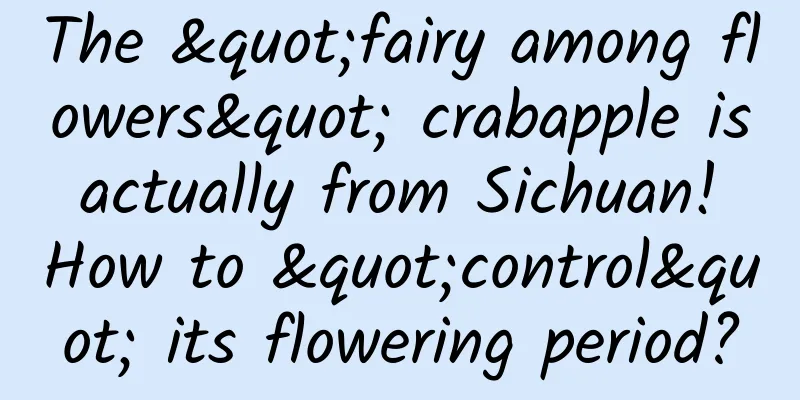The "fairy among flowers" crabapple is actually from Sichuan! How to "control" its flowering period?

|
The word "Begonia" was first seen in the Tang Dynasty's "Hundred Flowers Catalogue", and was called "the fairy among flowers". Planting crabapples was very popular in the Tang and Song dynasties. Crabapples were often planted with magnolias, peonies, and osmanthus in gardens, forming the artistic conception of "Jade and wealth". According to the Northern Song Dynasty's "Lengzhai Yehua", Emperor Minghuang of Tang, Li Longji, summoned Yang Guifei. The concubine was drunk and her makeup was incomplete, so she could not bow. Emperor Minghuang loved her very much and said that she was as beautiful and lovely as a crabapple flower that had not woken up. This is the origin of the allusion of "Begonia Spring Sleep". The crabapple is a shrub or small tree of the genus Malus in the family Rosaceae[1], which can reach 8 meters in height. The twigs are sturdy, cylindrical, with short soft hairs when young, which gradually fall off and become reddish brown or purple-brown and hairless when old. The buds in winter are ovate, gradually pointed at the tip, slightly covered with soft hairs, purple-brown, and with several exposed scales. The leaves are elliptical or oblong, 5-8 cm long and 2-3 cm wide. The fruit is nearly spherical, 2 cm in diameter, yellow, and 3-4 cm long. The flowering period is April-May, and the fruiting period is August-September. The crabapple generally grows in plains or mountains, with altitudes ranging from 50 to 2,000 meters. It is mainly distributed in Hebei, Shandong, Shaanxi, Jiangsu, Zhejiang, Yunnan and other places. It is said that Sichuan is the hometown of crabapples. The first poem of "A Hundred Poems on Crabapples" by Shen Li of the Song Dynasty reads: "A thousand miles of land in Min and Shu, crabapples are the most beautiful. Ten thousand crabapples bloom in this beautiful country, and the sun shines brightly in February." The so-called "bright sun in February" must refer to spring crabapples. However, in Sichuan, woody crabapples sometimes bloom in autumn after blooming in spring. Sichuan has many crabapples, and they bloom twice a year. In addition, Sichuan is the origin of crabapples, so many literati who have visited Sichuan have recited poems. [2] The first flower of the spring equinox is "Begonia". When a tree of Begonia blooms, spring comes early. The blooming of Begonia represents the arrival of spring. The flowering period of Begonia is from April to May, and the flowering period is one month. Different varieties of Begonia have different flowering times. Common varieties of Begonia in my country include Xifu Begonia, Stem Begonia, Weeping Begonia, Hubei Begonia, Four-season Begonia, Papaya Begonia, and Eight-angled Begonia. Among them, Four-season Begonia blooms most frequently, and the flowering period can last from March to December, and it blooms continuously throughout the year. Begonia not only has many varieties, but is also deeply loved by people because of its gorgeous beauty and elegance, and moderate light and dark colors. It has been given unique and elegant names such as "Shuke", "Shujin", "Chuanhong", and "Qionghua", as well as the titles of "Flower Concubine" and "Flower Noble", and is also known as "National Beauty". The crabapples described by literati are full of charm. In the chilly early spring, the crabapples are "the crabapples are not afraid of rouge color, standing alone in the misty drizzle", the crabapples after the rain in mid-spring are "the crabapples in the pond are full of red branches after the rain", the crabapples in bloom are "the spring scenery is like fairy clouds, and the fish on the water always have flowers", and the crabapples in the autumn dew and rain are "the crabapples in the courtyard are purple, reflecting the wind and rain". The crabapples are graceful and bloom like brocade, showing thousands of postures due to weather changes. However, the flowering time and flowering period of crabapples are closely related to the climate. For example, climate factors such as light and temperature will affect the early and late flowering of crabapples. Similarly, special circumstances will occur when the climate is abnormal. In early November 2017, the temperature in Nanjing had reached single digits, but several crabapple trees near Changgan Gate were in full bloom again. The almost leafless crabapple trees were not only in full bloom with gorgeous flowers, but also full of ripe fruits, forming a spectacle of "flowers and fruits on the same tree, flowers and fruits on the same branch". This is because this crabapple is called purple crabapple, which is a late-flowering variety that usually blooms in early to mid-April. Due to the alternating hot and cold temperatures that year, the flowers mistakenly thought that "spring has come", thus forming this spectacle. We can also take certain measures to make the crabapple bloom early or extend its flowering period. The crabapple flowers that bloom once a year in spring can bloom again in the autumn of the same year by adopting methods such as cooling, reducing water, and shading. The specific method is to move the potted crabapple trees to a cool place to avoid rain in early July to cool down, reduce light, and control watering. The amount of watering should be gradually reduced until the leaves of the plant turn yellow and fall off by themselves to induce dormancy. Then continue to water in small amounts. After a dormant period of 35-45 days, place the plant under full light, water it thoroughly, and add liquid fertilizer to wake it up and sprout new buds. After another 7-10 days, you can see bright and dazzling crabapple flowers. The reason why Chinese people love crabapple so much is because of its rich cultural connotations. People praise it as the "king of flowers" and the "noble concubine of flowers", and also regard it as a symbol of beautiful spring, beautiful women and good luck. References: [1]Wang Xiangguang. Analysis of phenotypic traits of different varieties of ornamental crabapple[D]. Qinhuangdao: Hebei Science & Technology Normal University, 2018. [2]Gao Fengping. A tree of pear blossoms overshadows the crabapple blossoms[J]. Shandong Human Resources and Social Security, 2023, No.410(07):59. Author: Hu Junyi (graduate student of College of Humanities and Development, China Agricultural University), Lv Dianzhen (undergraduate student of College of Plant Protection, China Agricultural University) Scientific review: Kuang Zongren (Associate Professor, College of Humanities and Development, China Agricultural University) |
<<: Why do some people get diarrhea when they are nervous?
>>: Hand-drawn long picture | The secret of migratory birds
Recommend
The latest national maternity leave map is out! The provinces with the longest paternity leave for men are actually these provinces...
Recently, many places across the country have ann...
JD.com 11.11 promotion tips, traffic acquisition strategy
As 11.11 is getting closer, almost all e-commerce...
A look at the pain of Khwarezm in start-up companies from Zhou Houjian's 1,000-word email
In the tide of entrepreneurship, there are so man...
Dentsu Digital team was dismissed: employees collectively reported CEO Zhang Zhexiang for bribing GAC executives
On January 8, it was reported that the Guangzhou ...
Battery dilemma: a game that can’t be stopped
At present, China has surpassed the United States...
Gamma Data: Development Prospects of AIGC in China’s Game Industry in 2023
AIGC Industry Development Background AI will beco...
The Mid-Autumn Festival and National Day are approaching. How do major brands do marketing?
It is said that there are less than 100 days left...
How to quickly and comprehensively build your own big data knowledge system?
Many people have read different types of books an...
2% market share is the reality for Apple TV, but Apple still wants to realize the ideal of "Disney"
Apple has always been a leader in the industry. F...
ELISA《YouTube Operation and Promotion Practical Skills》How to play YOUTUBE in the eyes of foreigners
Training course content: How to use YouTube in th...
Ang Lee's Father Trilogy: Eat Drink Man Woman, The Wedding Banquet, Pushing Hands HD Collection
When talking about Ang Lee’s most representative ...
How to use product thinking to look at the problem of Didi taxi being difficult and expensive?
User psychological expectations are a process tha...
Tik Tok operation and promotion plan, super detailed!
Recently, Douyin released the "2020 Spring F...
When operating Douyin, you must avoid 3 types of data traps
With the increasing popularity of short videos, m...









